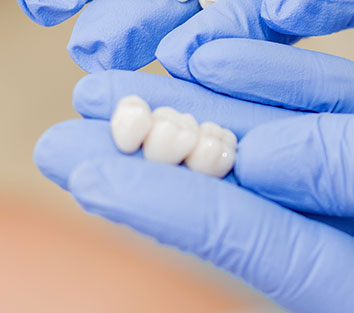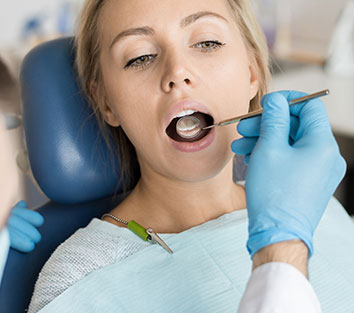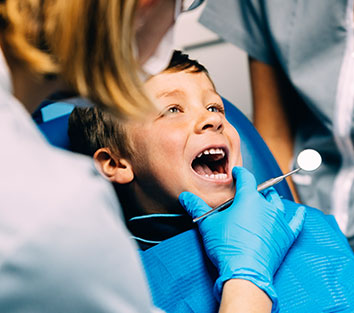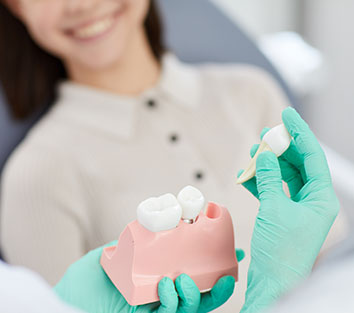


Create Online Appointment
Plan Your Appointment NowAsk Your Questions
to Our Doctors



What are the substances used for treatment of tooth decay?
What are the substances used for treatment of tooth decay? Zinc involving substances which are usually used temporarily Calcium involving healing substances Silver, tin, zinc, gold involving tough substances Glass, aluminum, phosphate and artificial resin including substances that are usually used in aesthetic purposes Substances containing aluminum silicate glass particles used for various purposes Prepared […]
Read More


How is tooth decay treated?
How is tooth decay treated? Tooth decays occur in patients who do not have well oral care and due to bacterial plaque and food remnants. Carbohydrate dominant nutrition, saliva fluidity, familial factors and oral care are the factors in tooth decay formation. What could be done in order to prevent tooth decays? Teeth should be […]
Read More


Can tooth decays be prevented?
Can tooth decays be prevented? Brushing the teeth after the breakfast and before sleeping and use of dental floss every day is the most efficient way. Because of the fact that food remnants accumulate in the recessions in the masticator surfaces and interdental spaces, tooth brushes should be small headed. Inner surfaces of the teeth, […]
Read More


Who develop tooth decay more commonly?
Who develop tooth decay more commonly? Those who consume carbohydrate and sugary foods commonly are under higher risk of decay. Although the saliva creates a defense mechanism against the acid produced by the bacterial plaque, it cannot prevent decays on its own. Diseases that reduce the saliva flow and amount or drugs may fasten decay […]
Read More


Do dental x-ray graphs harm my child?
Radiation of modern technique dental x-ray is minimal. Therefore, it does not harm any child. On the contrary, the benefit coming from the x-ray is very clear, considering the diagnostics.
Read More


What is dental x-ray?
What is dental x-ray? Dental x-ray graph is a technique for acquiring the image of invisible parts of bone and gingiva via x-ray use. Why is dental x-ray taken? Dental x-ray is a supportive method for diagnosing problems of teeth or jaws. For example, only large decays can be diagnosed with oral examination while early […]
Read More


Panoramic Radiography
Panoramic x-rays are used in every branches of dentistry. Maxilla, mandibular, all the teeth and surrounding tissues are examined on a single film. Fractures, pathologies, developmental anomalies of tooth and jaw, development of teeth and their directions during teething, positions of jaw joint and diagnostics, maxillary sinus can be evaluated. General structural relations of teeth […]
Read More


X-Rays and their use in Dentistry
Although there is not clear date about the first use of x rays in dentistry, it is first used in Germany and England in 1896. The first records about use of x-rays in dentistry in diagnostic purposes are reported by Dr. Wilhelm Koenig in Frankfurt, Germany. First use of x-rays in Turkey was conducted by […]
Read More


Dental Prosthesis
Materials prepared for repairing or replacing the teeth in case in which teeth and surrounding tissues suffer from substance loss or they are lost entirely are called “prostheses”. What is the purpose of dental prosthesis? While trying to regain the lost functions of the patient, it is also aimed to improve speech impediments and to […]
Read More


Prosthetic approaches
CROWN BRIDGE PROSTHESIS APPLICATIONS Tooth loss is not just reduction of mastication efficiency; it is also loss of aesthetics, speech, joint functions and smile, which fits humans the best. Communication of humans begins with speaking and shape with mimics. Dental losses affect mimics negatively too. Smiling, the first step of spreading positive energy begins with […]
Read More


Microendodontics
One of the latest developments in dentistry is possibility to conduct certain treatments under microscope. Along with possibilities of advanced technology, new treatment approaches came out in endodontics (canal treatment). As supported by many scientific researches, treatment success, endurance of treated tooth and its quality are increased. If the tissue inside the tooth is infected […]
Read More


Advanced Canal Treatment Techniques
Canal treatment is being applied in shorter terms and more efficiently and painlessly thanks to special equipment developed lately such as the profile. Canal treatment which took minimum a couple of sessions lately, can be done in one session with ‘profile’ and postoperative complications almost get to zero. Canal treatments that are done with using […]
Read More


Endodontic Surgery
Endodontic Surgery is a method which could be applied in teeth that are too infected to be treated with canal treatment. If the problem is chronic in the infected teeth and if it is a wide infection, canal treatment will not suffice on its own. In these cases, the part of tooth which is inside […]
Read More


Frequently Asked Questions in Endodontic Treatment
How long is the life of a canal treatment? Could canal treatment be unsuccessful? How long should you wait for restoration after canal treatment? Your dentist will offer canal treatment in order to save your teeth. Before talking about canal treatment, lets see how healthy teeth should be. Healthy teeth are made of crown (intraoral […]
Read More


What is Periodontology?
Periodontology is a branch of dentistry interested in treatment of diseases of soft and hard tissues around the teeth. In Greek, peri- means surroundings, odonto-tooth, logos-science, when these three words are brought together, periodontology means the science of surrounding tissues of teeth. These tissues are: Cement which forms the last layer of the root of […]
Read More


Unhealthy Gums (Gingiva)
Periodontal tissues are inflamed due to accumulation of microbial dental plaque which covers the teeth. It is a complex formation formed by bacteria, epithelium, other cellular wastes, various saliva proteins and food remnants. The plaque covering the teeth is a physiological process and it is not possible to prevent it from happening. The plaque, which […]
Read More


What is Tartar (calculus)?
Calculus or tartar is a product of minerals and plaques in your saliva. Tartar is the main cause of gingival diseases such as inflammation and periodontitis. Tartar creates the biggest problem especially when it is formed under the gingival line. Tartar is calcareous and hard, it is difficult to remove. Some parts of your dental […]
Read More


Definitions of Gingival Diseases (Gum Diseases)
Gingival response to certain factors varies according to age, gender, general health condition, systemic diseases, Professional factors and emotional status. Depending on the etiologic factor, the severity of this inflammatory response may be small or large. The most common type of gingival diseases is chronic gingival inflammation and it usually causes the periodontal disease to […]
Read More


Gingivitis Treatment and After
Gingivitis Treatment and After In very early periods of gingivitis, increasing patient’s oral hygiene and informing with microbial dental plaque control may be sufficient for treatment of the disease. Treatment of a progressed disease is made by cleaning of dental surface (tartar removal). In this treatment which takes at least two sessions, it is aimed […]
Read More


Milk Teeth – Space Holders
There are many causes of orthodontic problems. These are congenital and environmental causes. Tooth height-jaw size relation is at the top of congenital causes. “Crowding teeth” is inevitable if patient’s teeth are so large to fit in the jaw bone. Also, position of upper and lower jaws according to each other and basis of the […]
Read More


Before beginning to an orthodontic treatment
Orthodontic treatment is a special treatment method which is very different than other dental treatments. In order to get wanted results from this treatment, first of all making a right treatment plan and following this plan properly in an adequate frequency is important. Due to this special condition of orthodontic treatments, it must be applied […]
Read More


When should orthodontic treatment be done?
Although an orthodontist can make your smile better in any age, there is an optimum time for beginning to a treatment. Beginning the treatment during this time will make it to be more successful and to require less time and costs. American Association of Orthodontists advises this treatment to be done before the age […]
Read More


Orthodontics for Adults
Importance of a beautiful smile in human relations is an undeniable fact. Today, many adult individuals are in request of an orthodontic treatment in order to improve their look and health. Concerns of adults about orthodontic treatments are towards bad look of dental braces and treatment inefficiency after childhood ages. However, thanks to the advancements […]
Read More


Who is an Orthodontist?
Orthodontist is a dentist who is an expert in diagnosis and treatment of tooth and facial irregularities. In order to be an orthodontist, one must finish faculty of dentistry and complete a period of residency or a PhD which may take even longer. During this education, orthodontist learns the information for controlling the movement of […]
Read More


What is Orthodontics?
Orthodontics is a branch of expertise interested in diagnosis and treatment of teeth and facial irregularities of dentistry. Orthodontics is a word which derives from “orthos” which means straight in Latin and “dontos” which means tooth
Read More


What does bleeding gums cause and is there a treatment?
Bleeding gums refers to gum problems and it requires immediate care. Gum problems lead
Read More


The role of the teeth in speech
Speaking is the first and basic step of human communication. Some professions
Read More


SHOULD THE MILK TEETH BE TREATED?
Milk teeth are important for guiding the permanent teeth and functioning until they come out
Read More


What is dental x-ray and why is it used?
Dental x-ray graph is a technique for acquiring the image of invisible parts of bone and gingiva via x-ray use.
Read More


Dentist phobia
Fear is the reaction that people develop to unknown or known. These fears can be seen in
Read More


Check the sensitivity of your jaw joint and muscles
Take your finger into your ear, close and open your mouth a couple of times. Do you hear a click?
Read More


What causes dental pain, what does it refer to?
Dental pain refers to a variety of meanings according to severity and factors.
Read More


Gaining the habit of Tooth Brushing
Another common complaint I hear from the parents as a pedodontist is that children do not brush their teeth sufficiently. The easiest and best method for gaining this habit is to begin tooth brushing in early ages. As pediatric dentists, we advise parents to clean the teeth of their children as soon as their first […]
Read More


Oral-Dental Care for my baby
Question: When should my baby first visit a dentist? Answer: First dentist visit should be done when the first tooth comes out or on the first birthday. Do not forget that early diagnosis is the first step in prevention of problems that may occur later. Parents, podiatrists and dentists think differently on the topic of first dentist […]
Read More


A breakthrough in prevention of tooth decays; lollipops
Tooth decay is a contagious and infectious disease and it is transmitted to child from parents first. Xylitol affects st. mutans directly, which is responsible of tooth decay and play an important role in prevention of caries. Lollipops which just got into the market as a protective system against caries, is a simple and efficient […]
Read More


Tooth decay risk analysis
Tooth decay is an infectious disease. In today’s modern dentistry, it has been understood that biofilm plays an important role in formation of tooth decays. Biofilm layer is a protective layer present in every mouth which contains approximately 700 bacteria. In individuals who have high risk of caries, biofilm layer is formed by %96 pathogen […]
Read More


Fissure Sealants
Fissure Sealant is a fluent substance that covers the masticator surfaces of molar teeth and protects the teeth against caries. First molar teeth erupt in the ages between 5 and 7 in children. Second molar teeth become visible in mouth in 11 -14 in children. Researches showed that %90 of tooth decays begin in the […]
Read More


Oral and Dental Health for disabled people
The definition of disability is inability to do basic daily activities such as walking, hearing, seeing, breathing, standing up, reading, studying, talking, learning, thinking etc. due to physical or mental limitations. According to the research conducted by UNESCO, %10 of Turkish population is considered to be disabled. Research showed that frequency of oral and dental […]
Read More


When do the teeth erupt?
When do the teeth erupt? The first tooth erupts approximately in the middle of the 7th month. However, sometimes the first tooth appears early in the third month and sometimes it hangs until the end of a year. Tooth eruption usually obeys hereditary order, thus it is possible that it will be same if your or […]
Read More


Pacifiers and Dental Health of Babies
Pacifiers and Dental Health of Babies Is pacifier a safer thing than thumb sucking for my baby’s teeth? Usually, both habits affect the position of front teeth. Pacifiers may have bigger effect than thumb because pacifier is an elastic object which is deformed when pressurized and tries to return back to its natural shape later […]
Read More


Baby Bottle Tooth Decay
Baby Bottle Tooth Decay Baby bottle tooth decay will surprise and concern the mothers at first sight. Living through these conditions usually occurs in families who do not care adequately in their own oral and dental health. It is expected from people who are aware of the importance of oral and dental health to pass […]
Read More


Pediatric Orthodontics
Pediatric Orthodontics Most of the orthodontic problems occur due to early loss of teeth caused by caries formation in milk teeth. Early extraction of milk teeth will cause the space which is necessary for permanent teeth to be lost and therefore erupting permanent teeth will not find space in mouth. In some cases, even when […]
Read More


Inley-Onley Ceramic Fillings
The method of filling the cavity which developed after the decay in the teeth is cleaned is commonly applied. Use of ceramics with the purpose of filling became possible due to search of toughness along with aesthetics. Inley and Onley applications are procedures of closure of the cavity with ceramics which is made of ceramics […]
Read More


Adhesive System Bonding
Regaining function and aesthetics with minimum loss of substance became a principle in today’s dentistry. Magical mirror behind smiling is straight white teeth. Teeth with shape and color disorders prevent smiling in many environments and push the individual to loneliness in social events. Adhesive systems are additions to the tooth applied for changing the color […]
Read More


Smile Design
The key to self-trust, beginning of positive energy, combination of words with emotion, reflection of ego, and perfect charm of gift of expression belonging to humans of happiness begins with smiling. Lips bring red, teeth bring white into mind. What makes white is the absorption of certain amount of light and reflecting the rest as […]
Read More


Pathologic Surgery
Infections of teeth and gingiva which may go unnoticed for a long time may cause major damage in bone and soft tissue in time. As a result of this destruction, large lesions, cysts may develop in soft or hard tissues. In these cases, defect and cysts which develop in jaw bone are removed surgically. Also, […]
Read More


Tooth Extractions
In advanced dentistry of today, dental extractions are reduced to minimum. Even the teeth with only root inside can be treated and kept in. However, wisdom teeth may be a source of infection and they may be extracted due to their negative effects to other teeth. Apart from these, there are extractions in inconsistency cases […]
Read More


Impacted Teeth
What The Impacted Teeth? Teeth which do not come out to their places with various reasons even when it is time erupt are called “impacted teeth”. Third molar teeth (wisdom teeth) are the most common impacted teeth. If there is no place in the mouth for them to erupt and it did not erupt even […]
Read More


Implant Treatments
What is an Implant? Artificial roots shaped like a screw are called DENTAL IMPLANTS which are inserted in the jaw bone with the purpose of reshaping the lost teeth. Almost all of dental implants of today are titanium based because titanium is the most tissue-friendly material which can be consistent with bone tissue. What are […]
Read More


How effective is teeth whitening?
Chemicals are used to whiten the teeth. Level of whiteness
Read More
